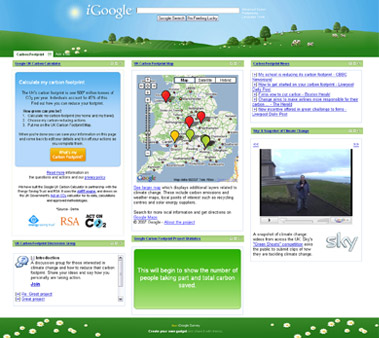
Google has launched the UK Carbon Footprint Project to help people in the UK to calculate, track and compare our carbon footprints with others living in the UK in 3 steps.
Step 1: When you decide to get started calculating your carbon footprint, Google will take you to your own personalised iGoogle page with a carbon calculator. Fill in your energy use details and Google will show you how your personal and travel footprint compares to the UK average.
Step 2: Then it’s time to choose from a number of small energy saving actions that you already do, or are willing to commit to doing. Hit recalculate and Google will work out how this reduces your carbon footprint, and compares it again to the UK average.
Step 3: Now you get to be brave (or brag a little) by adding your footprint to Google UK Carbon Footprint Map. The map can also be used to find resources and facts about the UK’s carbon emissions and climate change by comparing your footprint to others, and also looking at the availability of recycling facilities, various power sources (including renewables), local authority carbon emissions and recycling rates, building heat maps and energy rated locations from British Gas, and snapshots of climate change by Sky.
Your personalised iGoogle page also includes latest Climate Change News and a video about climate change. If you already use iGoogle, or have signed up to save your carbon calculator page, you can join the UK Carbon Footprint Discussion Group.
Google has built its carbon calculator in partnership with the Energy Saving Trust, The RSA, Act on CO2 and British Gas. The project also uses data from the Department for Environment, Food and Rural Affairs. It’s disappointing that there is no provision for including your food and shopping choices, both of which would have a considerable effect on your carbon footprint.
You can find out more about the project and Google’s partner’s here.